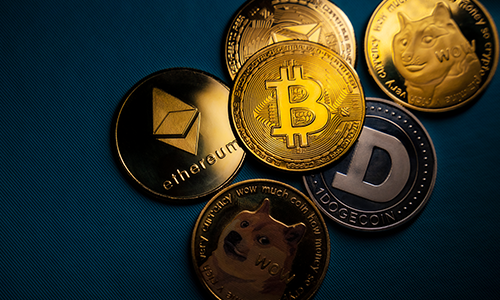
In the last article, we discussed some cryptocurrency basics, like what is it, is it legal, and where did it come from? So now that you’re up to speed on some of the basics, you might be wondering “how does it get value?”
There are people who are profiting from investing in crypto… so what makes it valuable?
How Cryptocurrency Gets Value
Let’s get into some economics! Think about supply and demand – if there’s a lot of something, it may not be as valuable. On the flip side, if there’s only a small amount of something, it’s more valuable. The same rings true about some cryptocurrencies.
Think about the money you’re used to, whether it’s in your wallet or bank account. It’s likely physical money issued by the government, like dollar bills or coins. That is called “fiat currency.” Fiat currency is government-issued currency that is not backed by a physical commodity, like gold or silver. Instead, the government backs the currency it issues, and retains the ability to levy taxes. The value of fiat currency is related to supply and demand, and the stability of the government that issues it. Since fiat money is backed by the issuing government, instead of a stockpile of gold or silver, it can print and produce more supply. However, it must be careful not to print too much, otherwise this can result in hyperinflation. Which hyperinflation is rapid, excessive price increases in the economy.
On the other side, commodity money has intrinsic value because of what it’s made from, or backed by. In other words, think about it like gold. There’s only a limited amount that exists, making it more valuable over time.
There is a limited supply of most, but not all, cryptocurrencies. Basically, a crypto’s source code outlines how many units will ever exist. Since many cryptocurrencies are decentralized, meaning no one person or entity controls it, it’s more similar to commodity money, like gold or precious metals.
But what about inflation? Glad you brought that up! Inflation measures the rate that average prices increase over time. Basically, it’s how life gets more expensive – as the value of a dollar declines, it requires more dollars to purchase something. Like when you could buy a car in 1980 for $7,000, and today the cost is around $40,000.
Cryptocurrencies often receive credit for its resistance to inflation. Commodity money retains its value because of the material used to create it, like precious metals or intrinsic value. As opposed to fiat currency, which isn’t based on precious metals or perceived worth, but rather public faith in the issuer.
Why Currencies Have Value
In order for a currency to be considered valuable, it needs to be reliable and hold it’s value over time. Aside from retaining value, a currency must also meet qualifications related to scarcity, divisibility, utility, transferability, and counterfeitability.
- Scarcity – how many units exist? Scarcity is the supply that exists of a currency. Too small of a supply can cause economic problems, and too large of a supply could cause prices of goods to increase.
- Divisibility – is the ability to break down currency units into smaller amounts. In order for currency to be a widely-accepted medium of exchange, it needs the flexibility to reflect the value of every good or service in the economy.
- Utility – is what makes currency useful, profitable, and beneficial. Users need to be able to reliably trade units of currency for goods and services.
- Transferability – allows participants to easily move currency within a country’s economy, as well as exchange with other nations.
- Counterfeitability – how easily can criminals create a fake version? A currency must be difficult to counterfeit to remain effective. Otherwise, criminals could flood the economy with fake copies, negatively impacting the currency’s value.
What Gives Cryptocurrency Value as a Currency?
Taking into account the above reasons a currency has value, there are a few reasons cryptocurrencies have value as a currency. Let’s see how crypto measures up!
- Scarcity – a limited supply of most cryptocurrencies exist. Bitcoin’s developer, for example, expressed there would only be a supply of 21 million tokens to exist. Currently, the supply of Bitcoins is around 18 million. Every four years, the rate Bitcoins are released decreases by half. Because of the continued releasing of tokens, mining for coins is spiking in popularity.
- Divisibility – Many crypto’s are able to be broken into smaller units. Taking Bitcoin for example, is divisible to eight decimal points. The smallest unit is equal to 0.00000001 Bitcoin, and is called a “Satoshi” after the developer. This small unit allows for quadrillions of individual units to be distributed globally.
- Utility – one of the biggest contributors to cryptocurrency’s success, is the blockchain technology on which it’s built. This ledger system is decentralized, so no participants need to establish trust with each other for the system to work correctly. Everyone has equal share of the information, and is incredibly difficult to alter.
- Transportability – due to the digital wallets, crypto exchanges, and other tools, cryptocurrency can be quickly transferred between parties.
- Counterfeitability – is incredibly difficult because of the complicated decentralized blockchain ledger system. Without getting too complicated, a criminal would need to essentially confuse all participants in the crypto network. Any attacks on a blockchain would require an overwhelming amount of effort, money, and computing power.